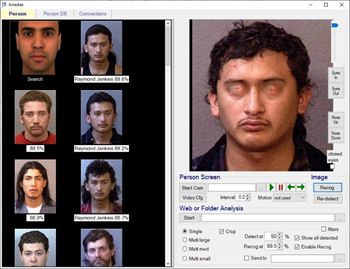the eyeballs are the key anchor points around which the characteristics of numerous facial features are measured.
The original design of f2 included the unique ability to match a selected part of a face, and to apply different weightings to different areas, making it possible to match only the selected part, and thus work with closed eyes and damaged faces. In partial mode Corpse-ID can work with two eyes (i.e. mailbox or balaclava view), one eye, and sometimes with no eyes at all.
In the above example the closed-eye face to be searched is copied into the box on the right, the eye centers are set manually, and the top matches are displayed as thumbnail images on the left.
When a victim is found an investigator will take several photos of their face. If the eyes are both visible and open the face can be matched immediately against the database. If the eyes are closed or the face is damaged it will be positioned over a generic facial template and the eye locations will be set manually.
Each of the shots will be encoded and matched against the encodings of all the faces in the database. Thumbnail images of matches above a user-defined threshold will be displayed for investigators to compare. Text filters, e.g. on gender, can be used to narrow down the number of potential matches where appropriate, for example where a face is heavily damaged and a number of distinguishing features are not visible.
CLICK on the button below to download the Corpse ID Product Information Sheet.


